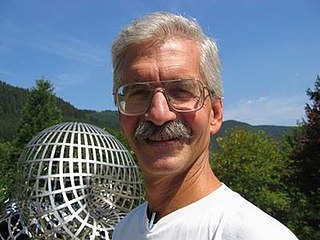Related Research Articles

William Paul Thurston was an American mathematician. He was a pioneer in the field of low-dimensional topology and was awarded the Fields Medal in 1982 for his contributions to the study of 3-manifolds.

John Willard Milnor is an American mathematician known for his work in differential topology, algebraic K-theory and low-dimensional holomorphic dynamical systems. Milnor is a distinguished professor at Stony Brook University and the only mathematician to have won the Fields Medal, the Wolf Prize, the Abel Prize and all three Steele prizes.

Nicholas Michael Katz is an American mathematician, working in arithmetic geometry, particularly on p-adic methods, monodromy and moduli problems, and number theory. He is currently a professor of Mathematics at Princeton University and an editor of the journal Annals of Mathematics.
Peter B. Shalen is an American mathematician, working primarily in low-dimensional topology. He is the "S" in JSJ decomposition.

In mathematics, a Schottky group is a special sort of Kleinian group, first studied by Friedrich Schottky.

James Gilbert Glimm is an American mathematician, former president of the American Mathematical Society, and distinguished professor at Stony Brook University. He has made many contributions in the areas of pure and applied mathematics.

Jeff Cheeger is an American mathematician and Silver Professor at the Courant Institute of Mathematical Sciences of New York University. His main interest is differential geometry and its connections with topology and analysis.

Dennis Parnell Sullivan is an American mathematician known for his work in algebraic topology, geometric topology, and dynamical systems. He holds the Albert Einstein Chair at the Graduate Center of the City University of New York and is a distinguished professor at Stony Brook University.
John Willard Morgan is an American mathematician known for his contributions to topology and geometry. He is a Professor Emeritus at Columbia University and a member of the Simons Center for Geometry and Physics at Stony Brook University.
Lipman Bers was a Latvian-American mathematician, born in Riga, who created the theory of pseudoanalytic functions and worked on Riemann surfaces and Kleinian groups. He was also known for his work in human rights activism.

Mladen Bestvina is a Croatian-American mathematician working in the area of geometric group theory. He is a Distinguished Professor in the Department of Mathematics at the University of Utah.
In the mathematical theory of Kleinian groups, a quasi-Fuchsian group is a Kleinian group whose limit set is contained in an invariant Jordan curve. If the limit set is equal to the Jordan curve the quasi-Fuchsian group is said to be of type one, and otherwise it is said to be of type two. Some authors use "quasi-Fuchsian group" to mean "quasi-Fuchsian group of type 1", in other words the limit set is the whole Jordan curve. This terminology is incompatible with the use of the terms "type 1" and "type 2" for Kleinian groups: all quasi-Fuchsian groups are Kleinian groups of type 2, as their limit sets are proper subsets of the Riemann sphere. The special case when the Jordan curve is a circle or line is called a Fuchsian group, named after Lazarus Fuchs by Henri Poincaré.

Irwin Kra is an American mathematician, who works on the function theory in complex analysis.

Claude R. LeBrun is an American mathematician who holds the position of Distinguished Professor of Mathematics at Stony Brook University. Much of his research concerns the Riemannian geometry of 4-manifolds, or related topics in complex and differential geometry.

Yair Nathan Minsky is an Israeli-American mathematician whose research concerns three-dimensional topology, differential geometry, group theory and holomorphic dynamics. He is a professor at Yale University. He is known for having proved Thurston's ending lamination conjecture and as a student of curve complex geometry.

Gerald Walter Schwarz is an American mathematician and Professor Emeritus at Brandeis University. Schwarz specializes in invariant theory, algebraic group actions and invariant differential operators.
David Gregory Ebin is an American mathematician, specializing in differential geometry.

Jeffrey Farlowe Brock is an American mathematician, working in low-dimensional geometry and topology. He is known for his contributions to the understanding of hyperbolic 3-manifolds and the geometry of Teichmüller spaces.
Christopher Bishop is an American mathematician on the faculty at Stony Brook University. He received his bachelor's in mathematics from Michigan State University in 1982, going on from there to spend a year at Cambridge University, receiving at Cambridge a Certificate of Advanced Study in mathematics, before entering the University of Chicago in 1983 for his doctoral studies in mathematics. As a graduate student in Chicago, his advisor, Peter Jones, took a position at Yale University, causing Bishop to spend the years 1985–87 at Yale as a visiting graduate student and programmer. Nonetheless, he received his PhD from the University of Chicago in 1987.
Albert Marden is an American mathematician, specializing in complex analysis and hyperbolic geometry.
References
- ↑ Bernard Maskit at the Mathematics Genealogy Project
- ↑ Past faculty, MIT Mathematics, retrieved 2015-01-22.
- ↑ Member profile, Institute for Advanced Study, retrieved 2015-01-21.
- ↑ Faculty web page, Stony Brook University, retrieved 2015-01-21.
- ↑ List of Fellows of the American Mathematical Society, retrieved 2015-01-21.
- ↑ Marden, Albert (1990), "Review: Bernard Maskit, Kleinian groups", Bull. Amer. Math. Soc., 22 (2): 310–315, doi: 10.1090/s0273-0979-1990-15895-1
- ↑ Review of Kleinian groups by William Abikoff (1990), MR 0959135
- ↑ Maskit, Bernard (1974), "Classification of Kleinian Groups" (PDF), Proceedings of the International Congress of Mathematicians, Vancouver, pp. 213–216, MR 0437749 .